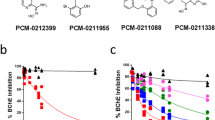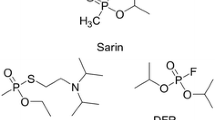Abstract
The in vitro inhibitory potencies of several nerve agents and other organophosphorus compounds against acetylcholinesterase (AChE) and neurotoxic esterase (NTE) have been compared. Although the I50s against AChE were about 0.1–1.0 nM for the nerve agents the I50s against NTE for sarin, soman and tabun were two to four orders of magnitude higher and VX had negligible activity. A series of bis[(ω-phenyl-n-alkyl]phosphorofluoridates inhibited both enzymes at 1.0–100 nM while ω-phenyl-n-alkyl NN-dimethylphosphoramidofluoridates were active at 0.1–10 μM. From the in vitro data it was predicted that nerve agents would cause delayed neuropathy only at doses greatly exceeding the LD50. In hens protected against acute toxicity by pretreatment with physostigmine, atropine and the oxime P2S, delayed neuropathy associated with high inhibition of NTE was found at 30–60 × LD50 for sarin but not at 38 × LD50 for soman or 82 × LD50 for tabun. At the maximum doses tested of the latter two compounds the inhibition of NTE was 55% and 66% respectively. The minimum neuropathic doses were calculated to be about 100–150 × LD50 for soman and tabun.
As expected from in vitro data, neuropathy, associated with a high level of inhibition of NTE, was caused by one of the bis-phenylalkyl phosphorofluoridates at doses causing negligible acute toxicity. The required dose was 9X that for DFP although the compound was 300X more active against NTE in vitro suggesting that such compounds are rapidly degraded in vivo. The phenylalkyl NN-dimethylphosphoramidofluoridates produced prolonged acute signs of poisoning but they were not neuropathic at the maximum tolerable doses nor was the NTE greatly inhibited contrary to the prediction from the in vitro data. It is possible that the enantiomer responsible for the inhibition of NTE is preferentially degraded in vivo.
Several other phosphoramidofluoridates inhibit NTE in vitro at 1.0–100 μM and a number of bicyclic phosphates were inactive at 23 μM. None of these compounds was tested in vivo.
Similar content being viewed by others
References
Berry WK, Davies DR (1970) The use of carbamates and atropine in the protection of animals against poisoning by 1,2,2,trimethylpropyl methylphosphonofluoridate. Biochem Pharmacol 19: 927–934
Davies DR (1963) Neurotoxicity of organophosphorus compounds. In: Koelle GB (ed) Handbuch der Experimentellen Pharmakologie vol XV, Springer, Berlin Heidelberg New York, p 860
Davies DR, Holland P, Rumens MJ (1960) The relationship between chemical structure and neurotoxicity of alkyl organophosphorus compounds. Br J Pharmacol 15: 271–278
Dirnhuber P, French MC, Green DM, Leadbeater L, Stratton JA (1979) The protection of primates against soman poisoning by pretreatment with pyridostigmine. J Pharm Pharmacol 31: 295–299
Finney DJ (1971) Probit analysis. (3rd edn) Cambridge University Press, London
Gordon JJ, Leadbeater L, Maidment MP (1978) The protection of animals against organophosphate poisoning by pretreatment with a carbamate. Toxicol Appl Pharmacol 43: 207–216
Hall CR, Inch TD, Inns RH, Muir AW, Sellers DJ, Smith AP (1977) Differences between some biological properties of enantiomers of alkyl S-alkyl methylphosphonothiolates. J Pharm Pharmacol 29: 574–576
Heilbronn E, Tolagen B (1965) Toxogonin in sarin, soman and tabun poisoning. Biochem Pharmacol 14: 73–77
Johnson MK (1969) The delayed neurotoxic effect of some organophosphorus compounds: identification of the phosphorylation site as an esterase. Biochem J 114: 711–717
Johnson MK (1975) The delayed neuropathy caused by some organophosphorus esters: mechanism and challenge. CRC Critical Rev Toxicol 2: 289–316
Johnson MK (1977) Improved assay of neurotoxic esterase for screening organophosphates for delayed neurotoxicity potential. Arch Toxicol 37: 113–115
Johnson MK (1981) Initiation of organophosphorus neurotoxicity. Toxicol Appl Pharmacol 61: 480–481
Johnson MK (1982) In: Hodgson E, Bend JR, Philpot RM (eds) Elsevier/North Holland, New York. Rev Biochem Toxicol 4: 141–212
Loomis TA, Salafsky B (1963) Antidotal action of pyridinium oximes in anticholinesterase poisoning; comparative effects of soman, sarin and neostigmine on neuromuscular function. Toxicol Appl Pharm 5: 685–701
Lotti M, Johnson MK (1978) Neurotoxicity of organophosphorus pesticides — predictions can be based on in vitro studies with hen and human enzymes. Arch Toxicol 41: 215–221
Author information
Authors and Affiliations
Rights and permissions
About this article
Cite this article
Gordon, J.J., Inns, R.H., Johnson, M.K. et al. The delayed neuropathic effects of nerve agents and some other organophosphorus compounds. Arch Toxicol 52, 71–82 (1983). https://doi.org/10.1007/BF00354767
Received:
Issue Date:
DOI: https://doi.org/10.1007/BF00354767




